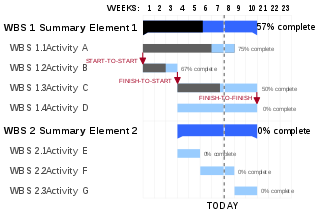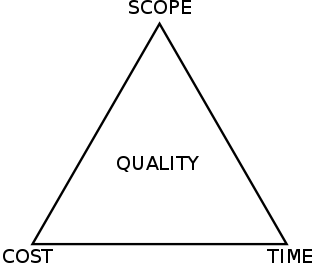Related Research Articles
Earned value management (EVM), earned value project management, or earned value performance management (EVPM) is a project management technique for measuring project performance and progress in an objective manner.
Project management is the process of supervising the work of a team to achieve all project goals within the given constraints. This information is usually described in project documentation, created at the beginning of the development process. The primary constraints are scope, time and budget. The secondary challenge is to optimize the allocation of necessary inputs and apply them to meet pre-defined objectives.

A work-breakdown structure (WBS) in project management and systems engineering is a deliverable-oriented breakdown of a project into smaller components. A work breakdown structure is a key project management element that organizes the team's work into manageable sections. The Project Management Body of Knowledge defines the work-breakdown structure as a "hierarchical decomposition of the total scope of work to be carried out by the project team to accomplish the project objectives and create the required deliverables."
A project plan, according to the Project Management Body of Knowledge (PMBOK), is: "...a formal, approved document used to guide both project execution and project control. The primary uses of the project plan are to document planning assumptions and decisions, facilitate communication among project stakeholders, and document approved scope, cost, and schedule baselines. A project plan may be sumarized or detailed."
Critical chain project management (CCPM) is a method of planning and managing projects that emphasizes the resources required to execute project tasks. It was developed by Eliyahu M. Goldratt. It differs from more traditional methods that derive from critical path and PERT algorithms, which emphasize task order and rigid scheduling. A critical chain project network strives to keep resources levelled, and requires that they be flexible in start times.

The critical path method (CPM), or critical path analysis (CPA), is an algorithm for scheduling a set of project activities. A critical path is determined by identifying the longest stretch of dependent activities and measuring the time required to complete them from start to finish. It is commonly used in conjunction with the program evaluation and review technique (PERT).
Project management software are computer programs that help plan, organize, and manage resources.

The program evaluation and review technique (PERT) is a statistical tool used in project management, which was designed to analyze and represent the tasks involved in completing a given project.

A Gantt chart is a bar chart that illustrates a project schedule. It was designed and popularized by Henry Gantt around the years 1910–1915. Modern Gantt charts also show the dependency relationships between activities and the current schedule status.
The rational unified process (RUP) is an iterative software development process framework created by the Rational Software Corporation, a division of IBM since 2003. RUP is not a single concrete prescriptive process, but rather an adaptable process framework, intended to be tailored by the development organizations and software project teams that will select the elements of the process that are appropriate for their needs. RUP is a specific implementation of the Unified Process.
In project management, a schedule is a listing of a project's milestones, activities, and deliverables. Usually dependencies and resources are defined for each task, then start and finish dates are estimated from the resource allocation, budget, task duration, and scheduled events. A schedule is commonly used in the project planning and project portfolio management parts of project management. Elements on a schedule may be closely related to the work breakdown structure (WBS) terminal elements, the Statement of work, or a Contract Data Requirements List.

In systems engineering, information systems and software engineering, the systems development life cycle (SDLC), also referred to as the application development life cycle, is a process for planning, creating, testing, and deploying an information system. The SDLC concept applies to a range of hardware and software configurations, as a system can be composed of hardware only, software only, or a combination of both. There are usually six stages in this cycle: requirement analysis, design, development and testing, implementation, documentation, and evaluation.
Construction management (CM) aims to control the quality of a project's scope, time, and cost to maximize the project owner's satisfaction. It uses project management techniques and software to oversee the planning, design, construction and closeout of a construction project safely, on time, on budget and within specifications.
Extreme programming (XP) is an agile software development methodology used to implement software systems. This article details the practices used in this methodology. Extreme programming has 12 practices, grouped into four areas, derived from the best practices of software engineering.

A schedule or a timetable, as a basic time-management tool, consists of a list of times at which possible tasks, events, or actions are intended to take place, or of a sequence of events in the chronological order in which such things are intended to take place. The process of creating a schedule — deciding how to order these tasks and how to commit resources between the variety of possible tasks — is called scheduling, and a person responsible for making a particular schedule may be called a scheduler. Making and following schedules is an ancient human activity.

Event chain methodology is a network analysis technique that is focused on identifying and managing events and relationships between them that affect project schedules. It is an uncertainty modeling schedule technique. Event chain methodology is an extension of quantitative project risk analysis with Monte Carlo simulations. It is the next advance beyond critical path method and critical chain project management. Event chain methodology tries to mitigate the effect of motivational and cognitive biases in estimating and scheduling. It improves accuracy of risk assessment and helps to generate more realistic risk adjusted project schedules.
A glossary of terms relating to project management and consulting.

The project management triangle is a model of the constraints of project management. While its origins are unclear, it has been used since at least the 1950s. It contends that:
- The quality of work is constrained by the project's budget, deadlines and scope (features).
- The project manager can trade between constraints.
- Changes in one constraint necessitate changes in others to compensate or quality will suffer.
The following outline is provided as an overview of and topical guide to project management:
Pre-construction services are services that are offered to support owners, architects, and engineers in making decisions. They are used in planning a construction project before the actual construction begins. The stage where these services are offered is called pre-construction or "pre-con".
References
- ↑ Harold Kerzner (2003). Project Management: A Systems Approach to Planning, Scheduling, and Controlling (8th ed.). Wiley. ISBN 0-471-22577-0.
- ↑ Heße, Robert (2023-04-08). "PROJECT MANAGEMENT DEMYSTIFIED" (in German). Retrieved 2023-06-11.
- ↑ "Definition of project planning methodologies with examples" . Retrieved 24 April 2014.
- ↑ Richard H. Thayer, Edward Yourdon (2000). Software Engineering Project Management (2nd ed.). Wiley-IEEE Computer Society Press. ISBN 0-8186-8000-8.
- ↑ Fleming, Quentin (2005). Earned Value Project Management (Third ed.). Project Management Institute. ISBN 1-930699-89-1.
- ↑ Filicetti, John, Project Planning Overview, PM Hut (Last accessed 8 November 2009).